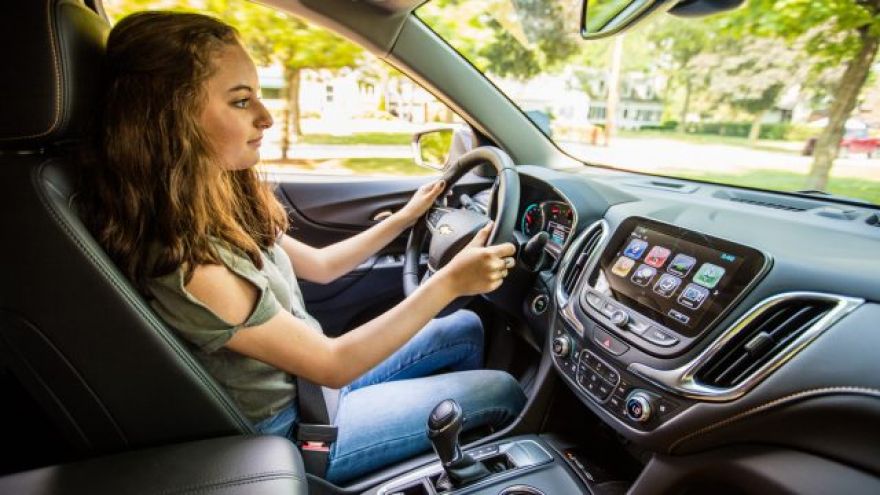
Most Car Infotainment Systems Increase Distraction, AAA Study Finds
The majority of car infotainment systems actually increase distraction, not ease it. So says the AAA Foundation for Traffic Safety and the University of Utah, which tested 30 different cars and found 23 create high or very levels of distraction across a range of scenarios. Only seven created what were described as moderate levels of distraction, and none reduced distraction. The information is helpful in setting the stage for more discussion and ignores longer-term trends, such as whether on-board navigation can be considered all that distracting when people were driving while reading folding paper maps 20 years ago.
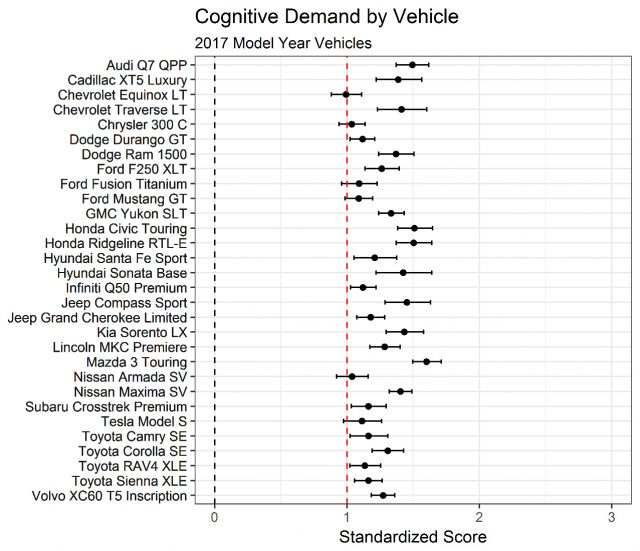
Cognitive demand placed on the driver in University of Utah / AAA Foundation study on driver distraction.
What AAA Tested
The is an offshoot of AAA, the longstanding drivers’ club for mainstream motorists. It partnered with the University of Utah, which did the research and compiled a 104-page report with a suitably academic title, Visual and Cognitive Demands of Using In-Vehicle Infotainment Systems (). Tests were conducted on the 30 2017 model year vehicles over a 2-mile, 25 mph public road, measuring how well the drivers, age 21-36, managed to perform tasks involving the navigation system, sending and receiving texts, calling and dialing on a connected smartphone, and using multiple music sources.
Here’s how the cars fared:
Very High Distraction (Based on AAA / U of Utah Tests)
- Audi Q7 QPP
- Chrysler 300 C
- Dodge Durango GT
- Ford Mustang GT
- GMC Yukon SLT
- Honda Civic Touring
- Honda Ridgeline RTL-E
- Mazda3 Touring
- Nissan Armada SV
- Subaru Crosstrek Premium
- Tesla Model S
- Volvo XC60 T5 Inscription
High Distraction
- Cadillac XT5 Luxury
- Chevrolet Traverse LT
- Dodge Ram 1500
- Ford Fusion Titanium
- Hyundai Sonata Base
- Infiniti Q50 Premium
- Jeep Compass Sport
- Jeep Grand Cherokee Limited
- Kia Sorento LX
- Nissan Maxima SV
- Toyota Rav 4 XLE
Moderate Distraction
- Chevrolet Equinox LT
- Ford F250 XLT
- Hyundai Santa Fe Sport
- Lincoln MKC Premiere
- Toyota Camry SE
- Toyota Corolla SE
- Toyota Sienna XLE
Minimal Distraction / Reduced Distraction
- None
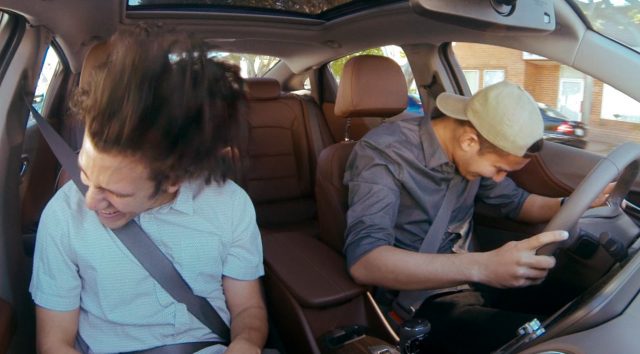
Some teens can provide their own distraction, helped by turning the volume knob to 11.
Surprising (?): Touch screen Easiest Input Method
Our experience has been that touch screens are fabulous when the vehicle is parked, but on a bouncy road, it’s a bear to accurately enter information, or even to make choices. Touch screens without buttons or knobs are more troublesome, so we’d expect something like Cadillac CUE to rate poorly (it’s in the high but not highest distraction category), whereas the simpler Chevrolet MyLink interface with more and larger buttons should be easier to use (Chevrolet Traverse rated high distraction, while Chevrolet Equinox rated moderate distraction).
The study ranked input methods from least to most distracting: touch screens and physical switches or knobs, voice commands, touchpads (“writing pads”), and dials or cockpit control wheels. Some input methods were not tested, such as Tinder-like swipe gestures.
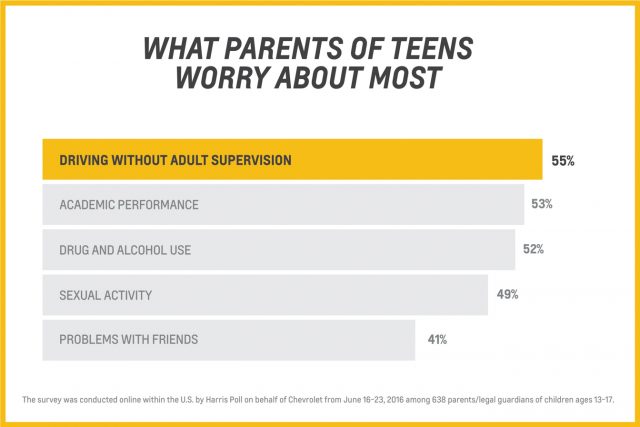
2016 Harris poll for Chevrolet says parents worry most about safe driving. Based on trends of the past 2-3 years, opioids and other drugs should get equal attention. But it’s not unusual to focus on, say, the potential of your child being kidnapped (low) versus injured in a crash because mom or dad didn’t make the back seat dwellers buckle up.
Broader Issues to Consider
Driver distraction is a huge issue to consider, so the report is timely and useful, as far as it goes. With more time and funding, there’s more to be learned. Here’s what we’d like to see as funds flow to learn more about auto injuries and fatalities:
Infotainment should be tested across multiple years. Consider Honda’s early 2010s system, with lots of buttons but a small screen. It was followed by Display Audio with zero buttons and zero knobs, not even voice or tuning. Honda finally relented two years ago and put back the volume knob, and now with the stellar 2018 ready to hit the market, Display Audio has eight buttons and two knobs.
Results should be broken out by LCD screen size and position. A big screen in the middle of the dash is easier to tap on; it’s easier to read when mounted on the top of the dash.
AAA could drill down on the radio tuning tasks, and see how easy or hard it is if there’s an external row of presets; sometimes the buttons can be used for nav destinations or favorite music choices.
The same tests should be run on Android Auto and Apple CarPlay to see if they’re easier to use. No matter what car they’re on, they work about the same. Also, it would be helpful to see how the recorded distraction levels change as drivers get more experience. Turning testers loose on the car today for a baseline, then letting them drive the same car for a month, then repeating the tests, would show how task times fall as drivers learn how to work the machines.
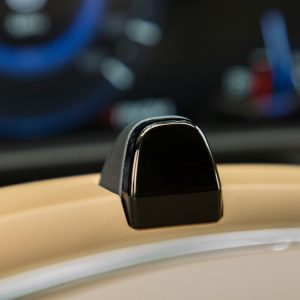
GM Super Cruise driver distraction camera.
There are teen driver tools that let parents set a volume limit on the infotainment system, or lock it at half-volume unless front seat belts are fastened. But other teen safety tools are limiting even if they sound good, such as a speedometer tattletale if the young driver, for instance, exceeds 50 mph. Now that car navigation typically includes road-by-road speed limit information, it would be a no-brainer to let parents set the tattletale at 5 mph above the posted speed, but so far no automaker has done that. Cadillac’s Super Cruise semi-autonomous driving system includes a camera with IR night lighting that warns if the driver’s eyes wander for more than 5-10 seconds. This would be great for teen (and all driver) safety were Super Cruise standard on something cheaper than the $85,000 (or a $5,000 option on CT6’s starting at $55,000).
When I test-drove Ford’s multi-million-dollar several years ago, I found it was possible to reduce distraction–if you really had to do something distracting–by breaking the task into multiple small chunks of interaction. This isn’t so much smart as it is less-stupid. But it helps.
Historical information is also useful. An AM/FM/cassette radio of the seventies is perhaps easier to use because you have fewer choices and big physical buttons. But the death toll then was about 4 per 100 million miles driven, while now it’s just over 1 per 100MM. There was a recent uptick the last two years, which safety advocates say is most likely linked to distractions.
Other distractions from the past were dangerous. The researchers are comparing cars from the 2017 model year. Go back to the period from just past World War II until the 1960s (first seat belts) and 1970s (first airbags): These cars more often lacked air conditioning, and driving with the windows open led to wind noise and buffeting that was tiresome. Two of the biggest distractions of the era, other than big hair getting caught in the sunroof, were dropping a lit cigarette in your lap and trying to deal with a bee that flew in the open window.
On an even broader level, when comparing where to spend resarch and prevention money, consider that auto fatalities have long been the leading cause of death among under-25s. But now, drug deaths (cheap opioids), homicides, and suicides are catching up, and in some cases surpassing car fatalities.
In short: The AAA Foundation/University of Utah report is useful. But there is much more to research and deeper to dig.